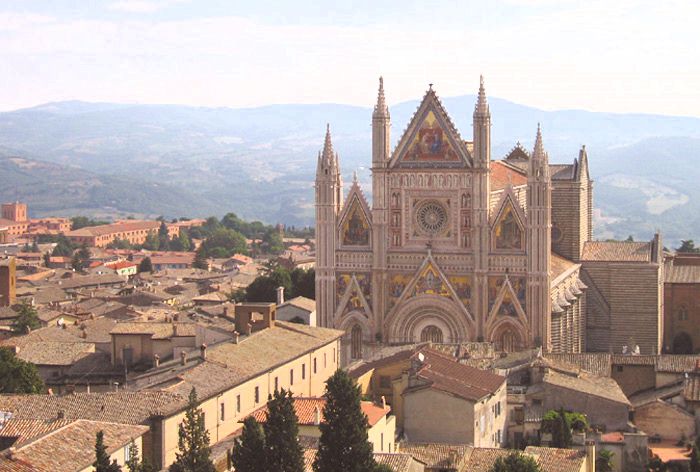

“Orvieto, Italy”
Orvieto sits atop an isolated mesa, 1033 ft above sea-level and 640 ft above the surrounding plain, offering unparalleled views of the Umbrian countryside. The town is now completely pedestrianised and can be reached on the east by a funicular railway from the station, or by escalators and a lift elsewhere. The town is very picturesque, particularly now that it is traffic-free, both due to its magnificent position and also the unusually large number of fine 13 C houses and palaces that still exist in its streets.
Orvieto's chief glory is its duomo, the splendid cathedral, dedicated to the Virgin Mary. It was begun before 1285, perhaps by Arnolfo di Cambio, on the site of an older church, and from the 13 C until the 16 C was enriched by the labours of a whole succession of great Italian painters and sculptors. The exterior is covered with black and white marble. The interior is of grey limestone with bands of a dark basaltic stone. The plan consists of a large rectangular nave, with semicircular recesses for altars, opening out of the aisles, north and south. There are two transeptal chapels and a short choir. The most magnificent part of the exterior and, indeed, the finest polychrome monument in existence, is the west façade, built of richly sculptured marble from the designs of Lorenzo Maitani of Sienna, and divided into three gables with intervening pinnacles, closely resembling the front of Sienna cathedral, from which it draws its inspiration. With the splendour of the whole, the beauty of the composition is marvellous, and it may rank as the highest achievement of Italian Gothic. It was begun in 1310, but the upper part was not completed till the 16 C. The mosaics are modern, and the structure has suffered somewhat from 19 C restoration. The four wall-surfaces that flank the three western doorways are decorated with very beautiful sculpture in relief, once ornamented with colour. The subjects are scenes from the Old and New Testaments, and the Last Judgment, with Heaven and Hell.
In the interior on the north, the Cappella del Corporale houses a large silver shrine, resembling in form the cathedral façade, enriched with countless figures in relief and subjects in translucent coloured enamels - one of the most important specimens of early silversmith's work
still extant in Italy. It was begun by Ugolino Vieri of Sienna in 1337, and was
created to hold the
Holy Linen of
Bolsena, which, according to the legend, became miraculously stained with blood during the celebration of mass to convince a sceptical priest of the truth of the doctrine of transubstantiation. This is supposed to have happened in 1263, while Urban
IV was residing at Orvieto. It was to commemorate this miracle that the existing cathedral was built. On the south side is the chapel of S. Brizio, separated from the nave by a fine
14 C wrought iron screen. The walls and vault of this chapel are covered with some of the best-preserved and finest frescoes in Italy. They
are among the noblest works of
Fra Angelico and Luca Signorelli, mainly painted between 1450 and 1501, the latter being of especial importance in the history of art owing to their great influence on
Michaelangelo in his early days. The choir stalls are fine and elaborate specimens of tarsia and rich wood-carving
and are the work of Antonio and Pietro della Minella (1431-1441).
The cathedral is especially rich in
16 C sculpture, containing as it does many statues, groups and altar-reliefs by Simone Mosca and Ippolito Scalza. |
Orvieto Italy © 2010 - 2020 ammonet InfoTech website design and promotion. All rights reserved.